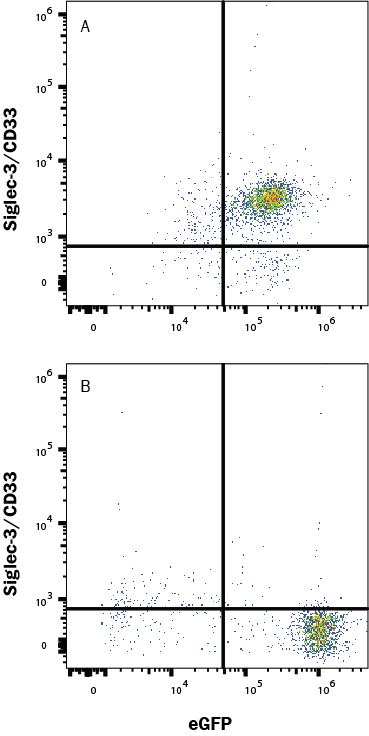Human Siglec-3/CD33 LlaMABodyTM Bivalent VHH Llama IgG2 Fusion Antibody
Human Siglec-3/CD33 LlaMABodyTM Bivalent VHH Llama IgG2 Fusion Antibody Summary
| Human Siglec-3/CD33 Specific Llama VHH domain | Llama Hinge | Llama IgG2 |
| N-terminus | C-terminus | |
Asp18-His259
Accession # AAA51948
Applications
Please Note: Optimal dilutions should be determined by each laboratory for each application. General Protocols are available in the Technical Information section on our website.
Scientific Data
 View Larger
View Larger
Detection of Siglec-3/CD33 in HEK293 Human Cell Line Transfected with Human Siglec-3/CD33 and eGFP by Flow Cytometry. HEK293 human embryonic kidney cell line transfected with either (A) human Siglec-3/CD33 or (B) irrelevant protein and eGFP was stained with Llama Anti-Human Siglec-3/CD33 Llamabody Native IgG Monoclonal Antibody (Catalog # LMAB10902) followed by Goat Anti-Llama Secondary Antibody (AF011), and then Allophycocyanin-conjugated Anti-Goat IgG Tertiary Antibody (F0108). Quadrant markers were set based on secondary plus tertiary antibody staining in the absence of primary antibody. View our protocol for Staining Membrane-associated Proteins.
Reconstitution Calculator
Preparation and Storage
- 12 months from date of receipt, -20 to -70 °C as supplied.
- 1 month, 2 to 8 °C under sterile conditions after reconstitution.
- 6 months, -20 to -70 °C under sterile conditions after reconstitution.
Background: Siglec-3/CD33
SARS-CoV-2, which causes the global pandemic coronavirus disease 2019 (Covid-19), belongs to a family of viruses known as coronaviruses that are commonly comprised of four structural proteins: Spike protein(S), Envelope protein (E), Membrane protein (M), and Nucleocapsid protein (N) (1). SARS-CoV-2 Spike Protein (S Protein) is a glycoprotein that mediates membrane fusion and viral entry. The S protein is homotrimeric, with each ~180-kDa monomer consisting of two subunits, S1 and S2 (2). In SARS-CoV-2, as with most coronaviruses, proteolytic cleavage of the S protein into two distinct peptides, S1 and S2 subunits, is required for activation. The S1 subunit is focused on attachment of the protein to the host receptor while the S2 subunit is involved with cell fusion (3-5). Based on structural biology studies, the receptor binding domain (RBD), located in the C-terminal region of S1, can be oriented either in the up/standing or down/lying state (6). The standing state is associated with higher pathogenicity and both SARS-CoV-1 and MERS can access this state due to the flexibility in their respective RBDs. A similar two-state structure and flexibility is found in the SARS-CoV-2 RBD (7). Based on amino acid (aa) sequence homology, the SARS-CoV-2 S1 subunit RBD has 73% identity with the RBD of the SARS-CoV-1 S1 RBD, but only 22% homology with the MERS S1 RBD. The low aa sequence homology is consistent with the finding that SARS and MERS bind different cellular receptors (8). The S Protein of the SARS-CoV-2 virus, like the SARS-CoV-1 counterpart, binds Angiotensin-Converting Enzyme 2 (ACE2), but with much higher affinity and faster binding kinetics (9). Before binding to the ACE2 receptor, structural analysis of the S1 trimer shows that only one of the three RBD domains in the trimeric structure is in the "up" conformation. This is an unstable and transient state that passes between trimeric subunits but is nevertheless an exposed state to be targeted for neutralizing antibody therapy (10). Polyclonal antibodies to the RBD of the SARS-CoV-2 protein have been shown to inhibit interaction with the ACE2 receptor, confirming RBD as an attractive target for vaccinations or antiviral therapy (11). There is also promising work showing that the RBD may be used to detect presence of neutralizing antibodies present in a patient's bloodstream, consistent with developed immunity after exposure to the SARS-CoV-2 virus (12). Lastly, it has been demonstrated the S Protein can invade host cells through the CD147/EMMPRIN receptor and mediate membrane fusion (13, 14).
- Wu, F. et al. (2020) Nature 579:265.
- Tortorici, M.A. and D. Veesler (2019). Adv. Virus Res. 105:93.
- Bosch, B.J. et al. (2003). J. Virol. 77:8801.
- Belouzard, S. et al. (2009) Proc. Natl. Acad. Sci. 106:5871.
- Millet, J.K. and G. R. Whittaker (2015) Virus Res. 202:120.
- Yuan, Y. et al. (2017) Nat. Commun. 8:15092.
- Walls, A.C. et al. (2010) Cell 180:281.
- Jiang, S. et al. (2020) Trends. Immunol. https://doi.org/10.1016/j.it.2020.03.007.
- Ortega, J.T. et al. (2020) EXCLI J. 19:410.
- Wrapp, D. et al. (2020) Science 367:1260.
- Tai, W. et al. (2020) Cell. Mol. Immunol. https://doi.org/10.1016/j.it.2020.03.007.
- Okba, N. M. A. et al. (2020). Emerg. Infect. Dis. https://doi.org/10.3201/eid2607.200841.
- Wang, X. et al. (2020) https://doi.org/10.1038/s41423-020-0424-9.
- Wang, K. et al. (2020) bioRxiv https://www.biorxiv.org/content/10.1101/2020.03.14.988345v1.
Product Datasheets
FAQs
-
What are Camelid Antibodies?
Camelid antibodies are antibodies from the Camelidae family of mammals that include llamas, camels, and alpacas. These animals produce 2 main types of antibodies. One type of antibody camelids produce is the conventional antibody that is made up of 2 heavy chains and 2 light chains. They also produce another type of antibody that is made up of only 2 heavy chains. This is known as heavy chain IgG (hcIgG). While these antibodies do not contain the CH1 region, they retain an antigen binding domain called the VHH region. VHH antibodies, also known as single domain antibodies or Nanobodies®, contain only the VHH region from the camelid antibody.
-
What is a llamabody VHH domain?
Camelids (ex: Llama) produce functional antibodies devoid of light chains of which the single N-terminal domain is fully capable of antigen binding. These single domain antibody fragments are known as VHH domains.
Reviews for Human Siglec-3/CD33 LlaMABodyTM Bivalent VHH Llama IgG2 Fusion Antibody
There are currently no reviews for this product. Be the first to review Human Siglec-3/CD33 LlaMABodyTM Bivalent VHH Llama IgG2 Fusion Antibody and earn rewards!
Have you used Human Siglec-3/CD33 LlaMABodyTM Bivalent VHH Llama IgG2 Fusion Antibody?
Submit a review and receive an Amazon gift card.
$25/€18/£15/$25CAN/¥75 Yuan/¥1250 Yen for a review with an image
$10/€7/£6/$10 CAD/¥70 Yuan/¥1110 Yen for a review without an image


